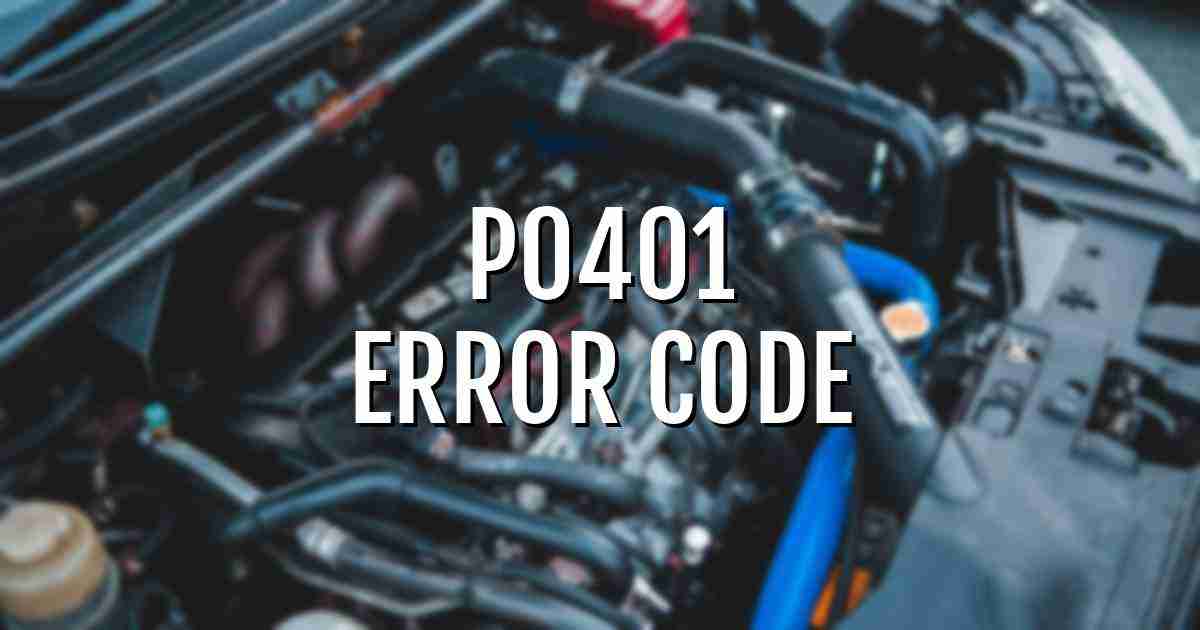OBD code P0401 indicates an issue with the Exhaust Gas Recirculation (EGR) system.
Symptoms include the Engine Light ON, engine hesitation.
Common causes are a clogged EGR passage, faulty EGR components, or electrical issues.
While not an immediate threat, it can affect vehicle performance.
To fix, inspect EGR components and wiring for damage or poor connections.
| Repair Importance Level | 6.67 (Out of 10) |
| Estimated Repair Time | Approximately 1.0 hour |
| Repair Difficulty Level | 6.67 (Out of 10) |
Symptoms of the p0401 OBD Code
The vehicle may experience reduced engine performance and increased fuel consumption with fault code P0401.
- With OBD code P0401, the Engine Light will be ON.
- Engine hesitation may occur.
Causes of the p0401 OBD Code
Do you know you can clear most fault codes—but some could mean serious danger? Don’t take chances with your safety or your family’s safety. This budget-friendly car scanner makes it easy to clear fault codes in seconds while showing you exactly what’s wrong. Plug it in, connect to your Android or iOS phone, and instantly check live data. You’ll know if it’s a minor issue you can clear or something serious that needs attention—so you can drive safely and stress-free. (Today’s Deal)
P0401 fault code typically indicates an issue with exhaust gas recirculation (EGR) flow insufficient detected.
- P0401 can be caused by a clogged EGR passage.
- A faulty EGR Vacuum Modulator Valve.
- A faulty EGR Valve.
- A faulty EGR solenoid valve.
- An open or shorted EGR solenoid valve harness.
- Poor electrical connection in the EGR solenoid valve circuit.
- A dead (weak) battery.
- A faulty EGR temperature sensor and circuit.
- Exhaust gas leaks.
Fixing Error Code p0401 Step By Step
To resolve fault code P0401, inspect and clean the EGR valve and passages for carbon buildup.
- To fix OBDII code P0401, start by reviewing the possible causes related to insufficient EGR flow.
- Visually inspect the EGR valve and passages for any carbon buildup or blockages.
- Check the vacuum lines connected to the EGR system for leaks or restrictions.
- Test the EGR valve position sensor for proper operation using a scan tool.
- Clean or replace the EGR valve if necessary.
- Reset the vehicle’s ECM to clear the fault code and monitor the system for any reoccurrence.
- If the issue persists, consider replacing the EGR valve position sensor or the EGR vacuum solenoid.
Cost Of Fixing p0401 Fault Code
Diagnosing and repairing fault code P0401 typically involves inspecting and cleaning the EGR system components.
The cost to diagnose and fix OBD code P0401 typically ranges from $75 to $150, with an estimated repair time of 1. 0 hour.
Costs depend on labor rates, shop location, and the complexity of the EGR system in the vehicle.
That fault code is a turning point. If repair costs are climbing and your current loan feels like it’s holding you back, this is the time to plan ahead. The free Car Loan Payment Tracker helps you see how quickly you can pay off what’s left—and start preparing, with confidence, for your dream car.
Details of the p0401 OBD Code
Code P0401 indicates insufficient EGR flow detected by the ECM.
OBD code P0401 means that there is insufficient flow detected in the Exhaust Gas Recirculation (EGR) system.
This code is triggered by the Engine Control Module (ECM) when it detects that the EGR flow is lower than expected.
The EGR system is responsible for recirculating a portion of the engine’s exhaust gas back into the intake manifold to reduce combustion temperatures and decrease the formation of nitrogen oxides (NOx).
When the ECM detects that the EGR flow is insufficient, it triggers the P0401 fault code to indicate a potential issue with the EGR system, such as a clogged EGR valve, faulty EGR temperature sensor, or restricted EGR passages.
Mechanic’s Tech Notes
Code P0401 indicates a malfunction in the Exhaust Gas Recirculation (EGR) system, often caused by a clogged EGR valve.
To diagnose and fix OBDII code P0401 (Exhaust Gas Recirculation Flow Insufficient Detected), start by checking the EGR valve for proper operation and carbon buildup.
Use a voltmeter to test the EGR position sensor and ensure it’s functioning correctly.
Inspect the vacuum lines for leaks or blockages.
Scan tools can help monitor EGR system data and perform a functional test on the EGR valve.
Cleaning or replacing the EGR valve, clearing carbon deposits, or repairing/replacing faulty components like the EGR position sensor or vacuum lines can often resolve this issue.
FAQ
Common causes of OBD code P0401 include a clogged EGR passage, faulty EGR components (valve, solenoid, vacuum modulator), electrical issues, exhaust leaks. Inspect components and wiring for damage.
Diagnose and fix OBD code P0401 by checking for clogged EGR passage, faulty EGR components, electrical issues, exhaust leaks. Inspect wiring and connectors for damage or corrosion.
It is not safe to continue driving with OBD code P0401. Possible causes include clogged EGR passage, faulty EGR components, and electrical issues that can affect engine performance.

Wrap Up
If your check engine light is on and you’re experiencing poor engine performance, you may have OBDII code P0401. This code typically indicates an issue with the Exhaust Gas Recirculation (EGR) system, such as a clogged EGR valve, faulty EGR temperature sensor, or carbon buildup in the EGR passages.
To address OBDII code P0401, start by inspecting the EGR valve and passages for blockages.
Check the EGR temperature sensor for proper operation and ensure the wiring harness and connectors are in good condition.
Cleaning or replacing the EGR

